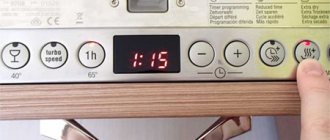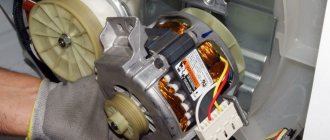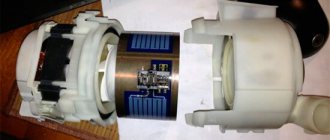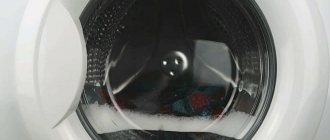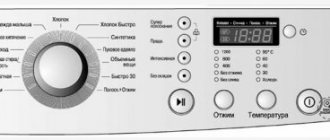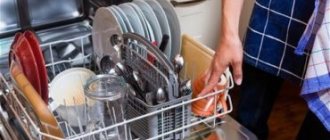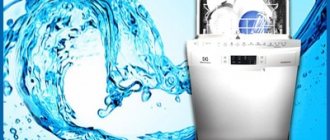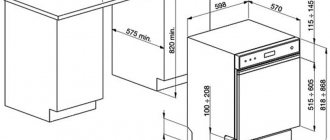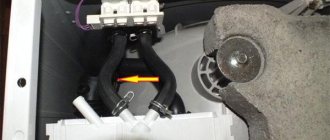Checking the correct use of the dishwasher
Often the cause of many malfunctions is failure to follow the manufacturer's instructions for operating the equipment. It is important to check that the dishwasher is being used correctly. First of all, you should make sure that there is water flowing into the tap. In apartments, water is supplied to the kitchen by one riser. If there is no water coming into the faucet, the dishwasher will not get any water either. Interruptions in the water supply often lead to temporary problems with the dishwasher.
It is important to use a suitable and high-quality detergent. The use of low-quality household chemicals can lead to serious malfunctions of the dishwasher. Usually the manufacturer gives recommendations regarding the choice of detergents.
The water supply valve may be closed. The mechanism is located at the point where the device hose connects to the water supply system. When the tap is closed, the equipment cannot draw water, so it must be opened.
Checking the correct operation of a dishwasher that does not receive water
Often, breakdowns occur due to neglect of the manufacturer’s recommendations and rules for using the device. Therefore, it is important to make sure that you did everything correctly. First, it is recommended to check the presence of water in the tap. One riser is used. Therefore, if there is no water in the tap, then the equipment will not be able to draw liquid. Problems with the water supply can cause temporary malfunctions of the dishwasher.
Be sure to check whether high-quality and correct detergent is used. This can cause serious problems over time. Therefore, you should use only recommended cleaning products.
Make sure the water supply valve is open. It is located at the junction of the hose and the plumbing system. If it is blocked, then liquid collection will not occur.
What to check first
The reasons why water does not flow into the machine are the same for dishwashers from Beko, Bosch, Ariston and others. The most modern models of dishwashers include the Aquastop system; sometimes it is this system that fails, but there are other problem areas.
Tap water
The first thing they do is go to the sink if the dishwasher hums when turned on, but does not fill with water. Open the tap. The sound of hissing and lack of water explain the cause of the malfunction. The device is working properly, there are problems with the water supply.
The door is not closed tightly
This is the most common reason. Many housewives are in a hurry and do not close the door all the way. In this case, the blocking is triggered. The indicators on the control panel are on, but the unit is silent. Water does not fill, the pump does not make noise. The problem can be easily solved. The door is opened and closed again until it clicks.
Water supply valve
When leaving the house (apartment) for a long period of time, the owners turn off the valve that connects the dishwasher hose to the water supply system. Upon returning, they forget to open it, turn on the device, and feel frightened.
If water does not flow into the machine, check the valve first.
Hose
Tap water can get scale and other debris into the device. It can damage the machine. To prevent this from happening, a mesh filter is installed at the point where the hose connects to the water supply network. When the mesh on the filter becomes clogged, water flows poorly into the tank, the dishwasher hums, but does not work.
This malfunction can be easily eliminated:
- unscrew the hose;
- remove the strainer;
- large particles are removed from it;
- the holes are cleaned with a needle;
- the plaque is cleaned off with a solution of citric acid, the strainer-filter is lowered into it for 1-1.5 hours.
Fill valve broken
The reasons why water cannot get into the dishwasher may be related to the operation of the fill valve. This valve is a rather sensitive element of the dishwasher and even a pressure drop can damage it. In particular, manufacturers of Bosch dishwashers in the instructions for their products indicate recommendations for installing a dishwasher if the pressure in the water supply is above 1 MPa. In addition to flow-through cleaning filters, they recommend installing pressure reducing valves.
If there is no pressure relief valve, and the water pressure is significant, then the dishwasher’s own fill valve will quickly break and either will not open at the right time, or, on the contrary, will remain open and water will constantly flow into the machine. In this case, it is almost impossible to repair the valve, because the mechanism breaks down and will have to be replaced. If the valve is simply clogged with dirt and does not open, then the problem can be solved by ordinary mechanical cleaning.
The water level sensor is to blame
The Bosch dishwasher seems to be humming and the lights are still on, but why doesn’t the water pour in? The culprit of this disgrace may be the pressure switch of the dishwasher. This device, also called a water level sensor, is required to accurately determine how much water is in the car at a given time. But the problem is that at one not very wonderful moment he may refuse to perform his function and then the following will happen:
- water will actually flow into the dishwasher, but the control module will not know about it;
- the machine will overflow and the pump will begin to pump out excess water in emergency mode;
- the control module, thinking that water is not flowing into the machine, generates a system error and stops the program.
It is not difficult to understand that this is exactly what happened to your dishwasher. Listen to whether there is water in the dishwasher, whether the pump is working, pumping out water, and whether the water is babbling in the drain hose and pipe. If all this takes place, then the first version that will need to be checked is a breakdown of the pressure switch. You can read about how to check and replace the pressure switch in the corresponding article published on our website.
When does the dishwasher not fill with water?
Sometimes situations arise when the dishwasher cannot draw the required amount of water within a certain period of time set by the manufacturer (for example, 10 minutes). In such cases, the PMM stops working, sometimes buzzes, and the display shows an alphanumeric error code. For example, dishwashers from Bosch and Siemens signal a similar emergency situation with codes E3, E8 or E15.
Error codes E3 and E8 appear when the PMM does not take in water
Liquid may not flow into the dishwasher tank for reasons that are easy to find out and fix yourself:
- There is no water in the water supply or its pressure is very low. This is easy to determine - turn on the faucet in the bathroom or kitchen.
- The water stop valve located at the entrance to the apartment or at the outlet of the tee through which liquid is supplied to the dishwasher is closed.
- Careless handling of the door resulted in the blocking sensor not working. In this case, the liquid will not flow into the PMM until the door is tightly closed.
- The inlet hose through which water enters the dishwasher is pinched. This may happen due to rearrangement of furniture or other reasons. Checking and restoring its patency is quite simple.
If you pull the inlet hose, it will bend and will not allow water to pass through.
In the above situations, restoring the water supply and the functionality of the PMM is quite simple, and anyone can do it. But there are more complex problems, the elimination of which requires certain knowledge and skills:
- The flow or inlet coarse filter is clogged. Typically, the inlet filter element is located where the inlet hose connects to the dishwasher body.
- The Aquastop protective module, which shuts off the water supply if there is a liquid leak in the dishwasher, has worked or failed (error code in the Bosch, Siemens PMM - E15).
- The device that locks the front door of the dishwasher has stopped working. In this case, the electronic control unit (hereinafter also referred to as the ECU) does not receive a signal to close the door and stops working.
- The inlet valve does not open (failure may be caused by a blockage or water hammer in the water supply system). There may be a missing control signal from the ECU.
- The water level sensor in the PMM tank (hereinafter also referred to as the pressure switch) is faulty. It may send an erroneous signal to the ECU that fluid has already been filled.
- The electronic control unit of the dishwasher has failed and does not provide a control signal to open the inlet valve.
Problems with water supply in different models of Bosch dishwashers
How many different models of Bosch dishwashers are there? They have various design features. The principle of filling with water may vary. The main differences between the second and third generation models. Different requirements for pressure and water quality. Water level sensors in Bosch dishwashers of different generations. They differ significantly in their operating principle. If the first ones have a mechanical pressure switch. More recent models use electronic water meters.
Models: SRV, SGV, SGI (Second Generation)
In Bosch dishwashers of this generation, more often than others, the lack of water supply is often associated with an electronic failure in the control module. After selecting the program and starting, depending on the water pressure. The machine should fill up and start working within 2-5 minutes. If This doesn't happen. And the dishwasher doesn't make any sounds. There may be a problem with water intake.
Dishwashers are more demanding of low water pressure. Because When the pressure in the system is low, incorrect filling occurs. And the dishwasher may not operate the wash cycle correctly. Hover or wash for a long time. Blockages in the water level sensor often lead to malfunctions, as well as excessive water consumption in general.
Models: SMV, SPV, SPS, SKS, SCE (Third generation)
These models use an electronic system for measuring water level, as well as monitoring the malfunction of the device as a whole. If there is a display, if the bosch dishwasher does not fill with water. It itself will signal a malfunction with an error on the display and the faucet indicator lighting up.
Unlike the second generation models. Dishwashers with an electronic level sensor are more demanding on the maximum water pressure in the system.
With excess pressure. The electronic sensor “does not have time” to process the signal about the arrival of water. This leads to malfunction and stops filling with water and the washing program as a whole.
Diagnosis of the causes and troubleshooting of the dishwasher
The most common reasons why your dishwasher won't fill with water include:
- the door is not tightly closed because the door lock is broken;
- the filter is clogged;
- the Aquastop system has blocked the fluid supply;
- the temperature sensor has broken or the heating element has burned out;
- problems with the control module;
- the filling valve has failed;
- The water level sensor is broken.
Some of the reasons can be eliminated yourself, for example, by cleaning the filters. More complex breakdowns require certain knowledge and special tools.
Advice. If your dishwasher is under warranty, contact a professional immediately.
The door is not closed tightly
The device door has a lock that protects it from leaks. When it is closed, the control module receives a signal that the door is locked, and the machine starts working. If the lock is broken, the door does not close until it clicks. There is no blocking signal, the program does not start and liquid is not collected.
If the lock breaks, you can change it yourself. How to do it:
- the dishwasher is disconnected from the power supply;
- unscrew the front panel;
- unscrew the broken door lock;
- install a new latch;
- screw the panel.
Filter clogged
An inlet valve filter is installed to protect equipment from dirt and debris that comes from the water supply. It is periodically cleaned or replaced. If liquid is drawn into the dishwasher too slowly or does not flow at all, then the reason is most often a clogged filter. They clean it on their own or call a professional.
Before cleaning, turn off the water supply. Unscrew the hose and remove the filter. It is located at the inlet of the intake valve. The mesh is washed under running water. If it is heavily soiled, clean it with a needle or dip it in a solution of citric acid (30 g per 1 l) for an hour. Then the cleaned filter is installed again and the hose is connected.
Aquastop worked
Dishwashers are equipped with a leakage protection system - Aquastop. Reasons why equipment stops working:
- the solenoid valve blocked the water supply due to a leak;
- the system itself failed.
There is no water in the dishwasher: the main reasons
There can be many reasons. Let's look at the main ones.
Thus, a malfunction may be caused by pinching of the supply hose, contamination of the inlet valve filter, or a breakdown of:
- door lock;
- intake valve;
- liquid level sensor (pressostat);
- control module;
- Aquastop systems.
| Problem | Description | Solution |
| Pinched supply hose | Incorrect element position | Giving the hose the correct position. |
| Inlet valve filter dirty | The filter protects the machine components from the negative effects of substances contained in tap water, however, over time it becomes dirty. | Cleaning the filter. |
| Door lock malfunction | The lock is located on the machine door and prevents injury to people and the occurrence of leaks. | Replacing the blocker. |
| Intake valve malfunction | The valve is available in all machines. When the unit is turned on, a signal is transmitted to the specified element, it opens, liquid fills the internal space. Failure of a unit is usually caused by voltage surges. | Change of part. |
| Malfunction of the liquid level sensor (pressostat) | A pressure switch is a structural element that measures the liquid level and transmits readings to the control module, which sets the volume of working medium required for a particular operating cycle. If the data is read and transmitted incorrectly, the water supply to the machine is stopped. | Changing the sensor. |
| Control module malfunction | The control module ensures the coordinated operation of all PMM units. In the case of liquid intake, it is he who gives the order to the inlet valve, and, naturally, failure of the module leads to failures in filling the machine. | Reprogramming the module or replacing it with a new one. |
| Malfunction of the Aquastop system | The system is available only in some models and is designed to protect the room from flooding. Filling may be suspended if a leak occurs or the system itself is damaged. | Repairing a leak or replacing an element. |
Read more ► Error E15 in a bosch dishwasher: explanation, how to fix it yourself
Advice. It is advisable to carry out repairs of dishwashers in specialized service centers that have qualified specialists on their staff.
Decoding errors
All dishwasher models have a self-diagnosis program. It protects the device from serious damage. In critical situations, an error code appears on the electronic display; the meaning of each is given in the operating instructions.
In any models, errors are grouped into categories:
- malfunctions of drainage and water supply;
- deviations in the water heating process;
- malfunctions of water sensors and switches;
- electrical problems.
The instructions for each error code contain a description of the probable malfunction and how to eliminate it. In the table of malfunctions of BOSCH models.
| Code | Decoding |
| E27/F27 | There was a power surge |
| E22/F22 | The filter is clogged |
| E01/F01 | Problems with the electronic unit |
| E3/F3 | No water coming in |
| E15/F15 | The leakage protection system has activated |
| E09/F09 | The heating element does not work |
| E24/F24 | Waste fluid does not drain |
| E25/F25 |
Causes of breakdowns
Most often, those components and elements of the dishwasher that fail are those that are subjected to mechanical stress during operation, have a complex design, or are in contact with poor-quality water. The causes of breakdowns are also associated with the listed factors.
Filter clogged
Tap water in our country is rarely absolutely pure. Various impurities, sand, rust and other debris are regularly supplied to our houses and apartments along with water.
These contaminants can damage the PMM, so all manufacturers proactively provide protection for their products from dirt. It is performed in the form of an input filter. Its mesh traps all the debris, but after some time it can become completely clogged and block the flow. Quite often, a hum is heard and the washing does not start.
In dishwashers, it is located on the inlet hose, at the point of connection to the body. Accordingly, you need to unscrew it, having first shut off the water supply to the riser.
External water supply problems
Problems arise not only due to a broken dishwasher, but also due to interruptions in the water supply. There may be no water supply either in the water supply itself or in the inlet hose.
A closed tap will also prevent you from using an automatic wash.
Aquastop failure
Violation of the tightness between the dishwasher components leads to the appearance of water in the pan. There is a leakage sensor there. If it works and gives a signal, the control system will automatically stop filling with water.
Sometimes false alarms occur when the sensor itself fails.
Problems with the door
The dishwasher door has a complex design and problems with it are not uncommon. There may be several reasons for this to not work:
- The locking mechanism is malfunctioning and the door cannot close completely. Because of this, the sensor does not work and the device does not start;
- the door lock is broken;
- The closing sensor does not work.
Sometimes all of the above happen at the same time.
Failure of the pressure switch
The volume of water poured into the dishwasher is monitored by a special device - a pressure switch. It is through it that the control board gives commands to start and stop water supply. If it does not work correctly, then it is possible that either the tank overflows and the “aquastop” is triggered, or the flow of water does not begin at all.
Constant supply and drainage of water by the dishwasher: solution to the problem
Constant collection and drainage of the PMM is one of the most common breakdowns.
Possible reasons may be:
- leak;
- failure of the pressure sensor (pressostat);
- intake valve malfunction;
- control board malfunction.
The breakdown itself is accompanied by constant intake and drainage, the appearance of one or another error code on the indicator, constant noise of the liquid being drawn in and the hum of the drainage pump.
The problem is solved by replacing a failed device module
Advice. To avoid system failure when loading and draining, you should unplug the dishwasher, let it rest for a short time and start it again. The absence of a positive effect will indicate a serious breakdown.
Troubleshooting problems with water supply to the PMM
If you have already checked everything that is possible, but water still does not flow into the system, then you need to inspect individual parts. Start by cleaning the filter and hose:
- close the shut-off valve;
- unscrew the inlet hose;
- behind it there is a filter mesh;
- rinse the parts under pressure from the tap; you can use a small brush to clean the hose.
At the same time, you can check the remaining details.
Fill valve
If water is not supplied to the Bosch dishwasher, the intake valve is inspected first. Visually check for mechanical damage on the surface of the part. To test the electronics, you need to apply voltage to the element, which will show whether the membrane opens or not.
The electrical part is tested with a multimeter, the resistance is measured and a verdict is made.
The intake valve cannot be repaired. You will need a complete replacement of the element, which you can do yourself. Disconnect the wiring and unscrew the screw securing the part. The main thing is to select an original spare part for the make and number of your car.
Hopper door
Until the chamber door is tightly closed, the machine will not start working. What if the door does not close all the way? Check:
- Seal. When it becomes deformed or comes out of its seat, it can interfere with normal closure.
- Latch. A broken lock will not make the door “click” and the system will not start.
- Placement of baskets and other camera elements. There may be something preventing the door from closing.
- Installation of PMM. Check the placement of the machine using a building level.
How to install a new door lock:
- open the bunker door;
- Unscrew the bolts around the perimeter of the inner part;
- remove the outer panel;
- disconnect the wiring;
- Unscrew the fastening screws and remove the lock;
- install the new element and connect the wiring.
- reassemble in reverse order.
We do not recommend replacing individual broken parts when trying to repair an old lock. This does not guarantee long-term use.
"Aquastop" system
First of all, check if there is any water in the pan. When a leak occurs, the protection float floats up, presses on the switch, and the water intake is blocked. When “Aquastop” is activated in the dishwasher, fault code E15 may appear on the display.
What to do:
- unscrew the hose from the body (if you have a mechanical Aquastop);
- look at the valve inside: if it is pressed tightly against the walls of the hose, then the protection needs to be replaced;
- To do this, disconnect the old hose and install a new one.
If you have an electromagnetic device, then additionally connect the wire to the sensor.
Level sensor
Incorrect pressure switch readings can also cause a lack of water. We wrote how to replace the level sensor in one of the articles. Most often, the device is a plastic box that is attached to the circulation pump. Checking its mechanics is very simple - blow into the pressure tube. If you hear clicks, the pressure switch is working.
The electrician is checked with a multimeter.
Electronic module
Modern Bosch dishwashers are equipped with a control module. He manages all processes in the machine and gives commands to the nodes. For example, drain the water from the bunker or start drawing water. If one of the board's triacs burns out, then some part stops functioning. Therefore, the module requires flashing or replacement.
Only a specialist can diagnose and repair the electronic board.
You can check the parts in your Bosch dishwasher yourself. Sometimes the reasons for the lack of water lie in a small blockage, so before calling a technician, make sure that the breakdown really exists.
